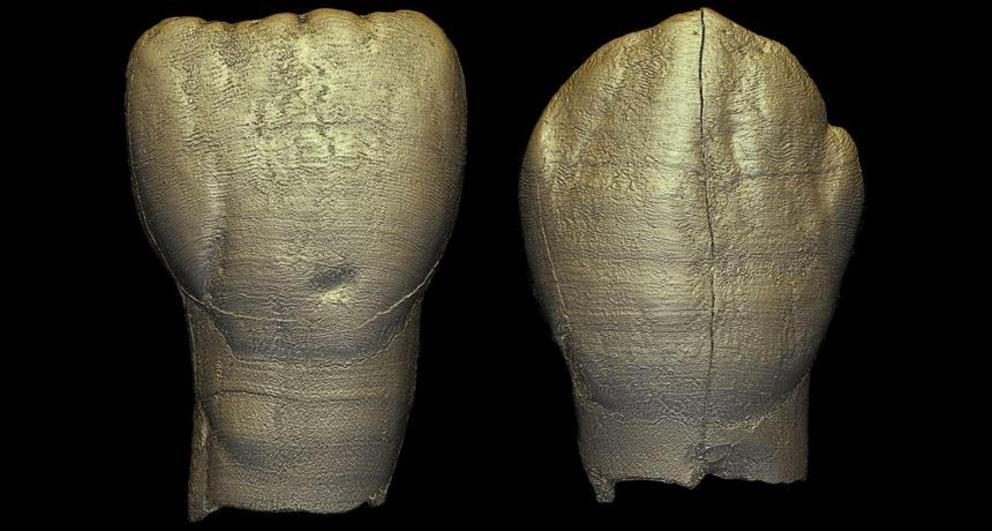An ancient child from East Asia grew teeth like a modern human
The youngster’s species is unknown for now

GROWING MYSTERY. An investigation of growth lines in an ancient East Asian child’s teeth (two digitally reconstructed teeth shown) uncovered a developmental pattern similar to that of modern humans. But the child’s species is unclear. S. Xing and Paul Tafforeau
An ancient child with a mysterious evolutionary background represents the oldest known case of humanlike tooth growth in East Asia, researchers say.
The child’s fossilized upper jaw contains seven teeth that were in the process of developing when the roughly 6½-year-old youngster died at least 104,000 years ago and possibly more than 200,000 years ago. Using X-rays to examine the teeth’s internal structure revealed that the first molar, which typically sprouts through the gums at around age 6 in kids today, had erupted a few months before death.
The root of that tooth was about three-quarters complete, similar to the pace of development in modern human children. Other tooth roots found in the fossil grew more rapidly than those of modern youngsters. But the ancient child’s overall dental growth and development falls within the range observed among kids today, paleoanthropologist Song Xing of the Chinese Academy of Sciences in Beijing and her colleagues report online January 16 in Science Advances.
That humanlike rate of dental development suggests that the youngster belonged to an East Asian Homo population with a relatively long life span and an extended period of child care, the researchers speculate. Those characteristics are associated with present-day humans’ lengthy period of tooth growth. But it’s hard to know where the child’s remains, unearthed with other hominid fossils at a northern Chinese site called Xujiayao in the late 1970s, fit in human evolution.
Identifying the Chinese fossils’ species is difficult because these finds have an unusual mix of features. A thick braincase and large teeth most resemble traits of Neandertals and Homo erectus, two now-extinct members of the genus Homo. Yet the shapes of several cheek teeth look most like corresponding teeth of Homo sapiens. Xing and colleagues suggest that it’s also possible that the Xujiayao fossils come from Denisovans, an enigmatic East Asian population known mainly from ancient DNA (SN: 8/5/17, p. 17). Fossil and ancient DNA analyses suggest that all four Homo species lived in the region during the period that the child’s fossil is dated to.
Regardless of species, the Xujiayao child provides the first peek at dental development in an ancient East Asian Homo population, says paleoanthropologist and study coauthor Debbie Guatelli-Steinberg of Ohio State University in Columbus. “Modern humans develop slowly, and at least for the first 6½ years of life, the dentition of the Xujiayao individual suggests that it also developed slowly,” she says.
Lines that form in teeth at regular intervals during childhood mark enamel layers that accumulate daily and over longer periods. The Xujiayao child’s age and dental growth rates were calculated by counting daily enamel layers. Intriguingly, a distinct growth line that forms about every eight days in human children’s enamel materialized more slowly in the Xujiayao child’s teeth, about every 10 days. But it’s hard to know from that one piece of evidence whether the ancient child matured even more slowly than youngsters today do, the researchers caution. The same growth line appears about every seven days in other fossil hominids.
It’s also not known whether the ancient child’s teeth would have continued to develop at a relatively slow, humanlike rate after age 6½. And it’s unclear if the rest of the child’s skeleton matured gradually.
Because the species ID of the Xujiayao child is up for grabs, the significance of its slowed tooth growth is murky, says paleoanthropologist Tanya Smith of Griffith University in Nathan, Australia. Smith, who did not participate in the new study, investigates dental development in ancient hominids.
If the Chinese find belongs to H. sapiens, its dental growth rate and other tooth traits align with those of fossil H. sapiens from Israel and North Africa dating to as early as around 300,000 years ago (SN: 7/8/17, p. 6), Smith says.
H. sapiens, as well as H. erectus and Neandertals, display a wide range of sometimes overlapping dental traits and growth rates over time (SN Online: 2/18/15), she adds. That complicates classification efforts based on teeth alone. Extracting DNA from the Chinese youngster’s jaw or teeth would help to clarify its evolutionary standing. No such DNA retrieval attempts have yet been made, Guatelli-Steinberg says.
